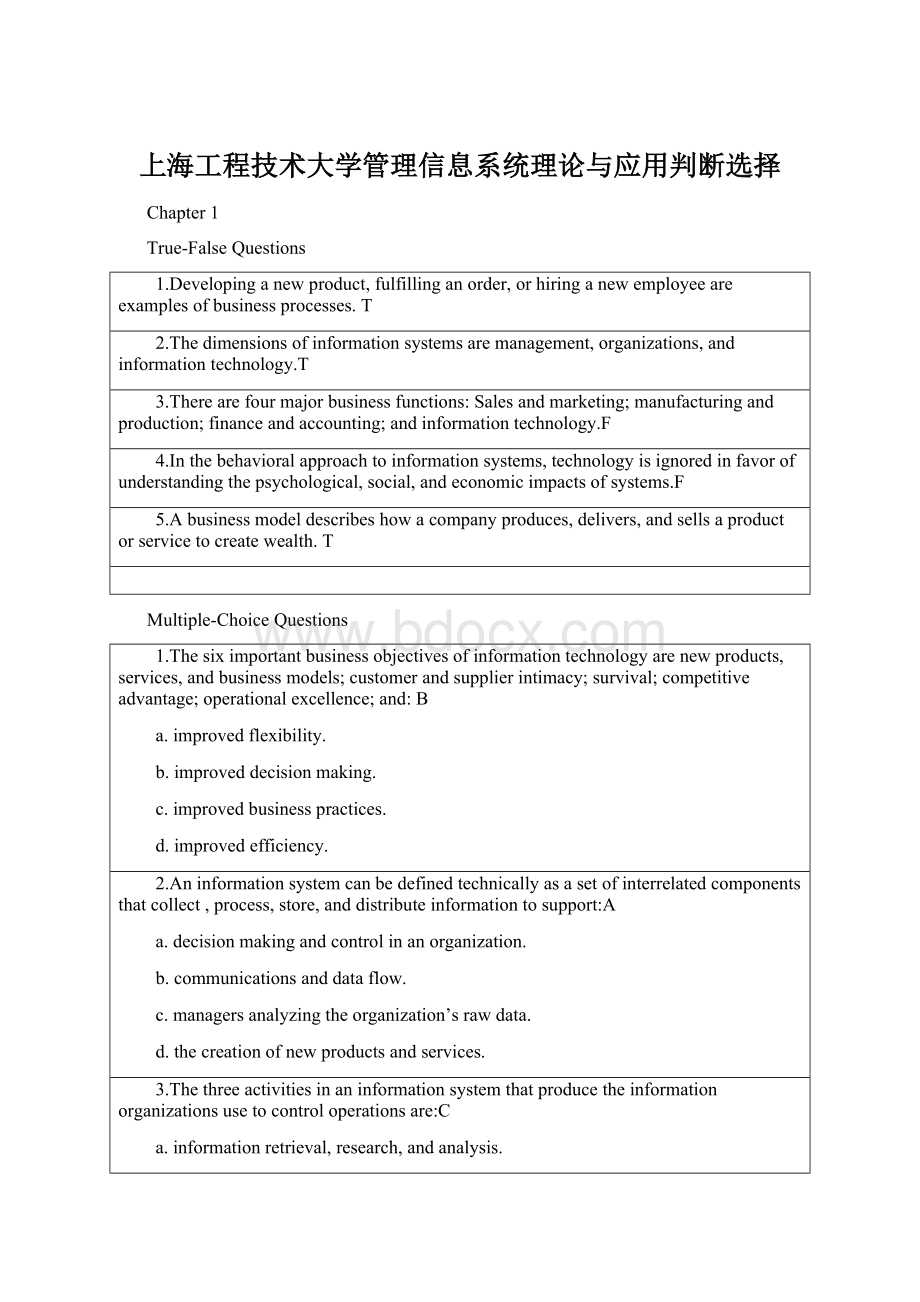 上海工程技术大学管理信息系统理论与应用判断选择.docx
上海工程技术大学管理信息系统理论与应用判断选择.docx
- 文档编号:7763603
- 上传时间:2023-01-26
- 格式:DOCX
- 页数:15
- 大小:22.72KB
上海工程技术大学管理信息系统理论与应用判断选择.docx
《上海工程技术大学管理信息系统理论与应用判断选择.docx》由会员分享,可在线阅读,更多相关《上海工程技术大学管理信息系统理论与应用判断选择.docx(15页珍藏版)》请在冰豆网上搜索。

上海工程技术大学管理信息系统理论与应用判断选择
Chapter1
True-FalseQuestions
1.Developinganewproduct,fulfillinganorder,orhiringanewemployeeareexamplesofbusinessprocesses.T
2.Thedimensionsofinformationsystemsaremanagement,organizations,andinformationtechnology.T
3.Therearefourmajorbusinessfunctions:
Salesandmarketing;manufacturingandproduction;financeandaccounting;andinformationtechnology.F
4.Inthebehavioralapproachtoinformationsystems,technologyisignoredinfavorofunderstandingthepsychological,social,andeconomicimpactsofsystems.F
5.Abusinessmodeldescribeshowacompanyproduces,delivers,andsellsaproductorservicetocreatewealth.T
Multiple-ChoiceQuestions
1.Thesiximportantbusinessobjectivesofinformationtechnologyarenewproducts,services,andbusinessmodels;customerandsupplierintimacy;survival;competitiveadvantage;operationalexcellence;and:
B
a.improvedflexibility.
b.improveddecisionmaking.
c.improvedbusinesspractices.
d.improvedefficiency.
2.Aninformationsystemcanbedefinedtechnicallyasasetofinterrelatedcomponentsthatcollect,process,store,anddistributeinformationtosupport:
A
a.decisionmakingandcontrolinanorganization.
b.communicationsanddataflow.
c.managersanalyzingtheorganization’srawdata.
d.thecreationofnewproductsandservices.
3.Thethreeactivitiesinaninformationsystemthatproducetheinformationorganizationsusetocontroloperationsare:
C
a.informationretrieval,research,andanalysis.
b.input,output,andfeedback.
c.input,processing,andoutput.
d.dataanalysis,processing,andfeedback.
4.Theaveragenumberofticketssolddailyonlineisanexampleof:
C
a.input.
b.rawdata.
c.meaningfulinformation.
d.feedback.
5.Whichofthefollowingareenvironmentalactorsthatinteractwithanorganizationanditsinformationsystems?
D
a.Customers
b.Suppliers
c.Regulatoryagencies
d.Alloftheabove
Chapter2
True-FalseQuestions
1.Ahotelreservationsystemisatypicalexampleofamanagementinformationsystem.F
2.Atransactionprocessingsystemisacomputerizedsystemthatperformsandrecordsthedailyroutinetransactionsnecessarytoconductbusiness.T
3.Supplychainmanagementsystemsaremoreexternallyorientedthanenterprisesystems.T
4.Informationsuppliedbyanenterprisesystemisstructuredaroundcross-functionalbusinessprocesses.T
5.Enrollingemployeesinbenefitsplansisabusinessprocesshandledbythefinanceandaccountingfunction.F
Multiple-ChoiceQuestions
1.Identifyingcustomersisaresponsibilityofthe______D___function.
a.financeandaccounting.
b.Humanresources.
c.Manufacturingandproduction.
d.Salesandmarketing.
2.Whichtypeofsystemwouldyouusetodeterminewhattrendsinyoursupplier’sindustrywillaffectyourfirmthemostinfiveyears?
A
a.ESS
b.TPS
c.MIS
d.DSS
3.E-governmentreferstotheapplicationof____A_____todigitallyenablegovernmentandpublicsectoragencies’relationshipwithcitizens,businesses,andotherarmsofgovernment.
a.theInternetandnetworkingtechnologies
b.e-commerce
c.e-business
d.Anycomputerizedtechnology
4._B________systemcollectsdatafromvariouskeybusinessprocessesandstoresthedatainasingle,comprehensivedatarepository,usablebyotherpartsofthebusiness.
a.transaction
b.enterprise
c.automaticreporting
d.managementinformation
5.Theterm“managementinformationsystems”designatesaspecificcategoryofinformationsystemsserving:
D
a.integrateddataprocessingthroughoutthefirm.
b.transactionprocessreporting.
c.employeeswithonlineaccesstohistoricalrecords.
d.middlemanagementfunctions.
Chapter3
True-FalseQuestions
1.Fromthepointofviewofeconomics,informationsystemstechnologycanbeviewedasafactorofproductionthatcanbesubstitutedfortraditionalcapitalandlabor.T
2.Stronglinkagestocustomersandsuppliersdecreaseswitchingcosts.F
3.Inthevaluechainmodel,primaryactivitiesaremostdirectlyrelatedtotheproductionanddistributionofthefirm’sproductsandservicesthatcreatevalueforthecustomer.T
4.Inthestrategyofproductdifferentiation,informationsystemsareusedtoenablenewproductsandservices.T
5.Inademonstrationofnetworkeconomics,themorepeoplethatuseAdobesoftwareandrelatedproducts,thegreaterthevalueofthesoftware.T
Multiple-ChoiceQuestions
1.WhichofthefollowingwouldNOTbeconsideredadisruptivetechnology?
A
a.Instantmessaging.
b.e-mail.
c.Internettelephony.
d.PCs.
2.Accordingtoagencytheory,thefirmisviewedasa(n):
D
a.unified,profit-maximizingentity.
b.taskforceorganizationthatmustrespondtorapidlychangingenvironments.
c.entrepreneurialendeavor.
d.“Nexusofcontracts”amongself-interestedindividuals.
3.WhichofthefollowingisNOToneofthecompetitiveforces?
C
a.Suppliers
b.Othercompetitors
c.Externalenvironment
d.Customers
4.Aninformationsystemcanenableacompanytofocusonamarketnichethrough:
D
a.complextrendforecasting.
b.tailoringproductstotheclient.
c.intensiveproducttrendanalysis.
d.intensivecustomerdataanalysis.
5.AllofthefollowingaremajorfeaturesoforganizationsthatimpacttheuseofinformationsystemsEXCEPTfor:
D
a.businessprocesses.
b.environments.
c.goals.
d.agencycosts.
Chapter4
True-FalseQuestions
1.Privacyistherighttobeleftalonewhenyouwanttobe,withoutsurveillanceorinterferencefromotherindividualsororganizations.T
2.Thelaststepinanalyzinganethicalissueshouldbetoidentifythestakeholderspeoplewhohaveavestedinterestintheoutcomeofthedecision.F
3.AcookieisasmallfilecontaininginformationaboutyouandyourWebactivitiesthatisdepositedonyourharddiskbyaWebsite.T
4.Accordingtothecourts,inthecreationofuniquesoftware,similarconcepts,generalfunctionalfeatures,andevencolorsareprotectablebycopyrightlaw.F
5.Spywareissoftwarethatcomeshiddeninfreedownloadablesoftwareandcantrackyouronlinemovements.T
Multiple-ChoiceQuestions
1.Whichofthefollowingbestdescribeshownewinformationsystemsresultinlegalgrayareas?
B
a.Theyworkwithnetworked,electronicdata,whicharemoredifficulttocontrolthaninformationstoredmanually.
b.Theyresultinnewsituationsthatarenotcoveredbyoldlaws.
c.Theyareimplementedbytechniciansratherthanmanagers.
d.Theyarecreatedfromsetsoflogicalandtechnologicalrulesratherthansocialororganizationalmores
2.Intheinformationage,theobligationsthatindividualsandorganizationshaveconcerningrightstointellectualpropertyfallwithinthemoraldimensionof:
A
a.propertyrightsandobligations.
b.systemquality.
c.accountabilityandcontrol.
d.informationrightsandobligations.
3.Thefeatureofpoliticalsystemsinwhichabodyoflawsisinplacethatpermitsindividualstorecoverthedamagesdonetothembyotheractors,systems,ororganizationsisreferredtoas:
D
a.accountability.
b.responsibility.
c.dueprocess.
d.liability.
4.Acolleagueofyoursfrequentlytakessmallamountsofofficesupplies,notingthatthelosstothecompanyisminimal.Youcounterthatifeveryoneweretotaketheofficesupplies,thelosswouldnolongerbeminimal.Yourrationaleexpresseswhichhistoricalethicalprinciple?
a.Kant’sCategoricalImperativeA
b.TheGoldenRule
c.Descartes’RuleofChange
d.The“Nofreelunch”rule
5.ImmanuelKant’sCategoricalImperativestatesthat:
D
a.ifanactioncannotbetakenrepeatedly,thenitisnotrighttobetakenatanytime.
b.oneshouldtaketheactionthatproducestheleastharmorincurstheleastcost.
c.onecanputvaluesinrankorderandunderstandtheconsequencesofvariouscoursesofaction.
d.ifanactionisnotrightforeveryonetotake,itisnotrightforanyonetotake.
Chapter9
True-FalseQuestions
1.Enterprisesystemsaredesignedprimarilytoallowcommunicationbetweenanorganizationandoutsidepartnersandsuppliers.F
2.Thebullwhipeffectisthedistortionofinformationaboutthedemandforaproductasitpassesfromoneentitytothenextacrossthesupplychain.T
3.Inapull-basedmodel,productionmasterschedulesarebasedonforecastsofdemandforproducts.F
4.YouwouldexpecttofindPRMandERMmodulesinthemostcomprehensiveCRMsoftwarepackages.T
5paniescanuseconfigurationtablesprovidedbytheenterprisesoftwaretotailoraparticularaspectofthesystemtothewayitdoesbusiness.T
Multiple-ChoiceQuestions
1.Asuiteofintegratedsoftwaremodulesforfinanceandaccounting,humanresources,manufacturingandproduction,andsalesandmarketingthatallowsdatatobeusedbymultiplefunctionsandbusinessprocessesbestdescribes:
B
a.SCMsoftware.
b.ERPsystems.
c.ERMsoftware.
d.CRMmodules.
2.Inordertoachievemaximumbenefitfromanenterprisesoftwarepackage,abusiness:
C
a.customizesthesoftwaretomatchallofitsbusinessprocesses.
b.usesonlytheprocessesinthesoftwarethatmatchitsownprocesses.
c.changesthewayitworkstomatchthesoftware’sbusinessprocesses.
d.selectsonlythesoftwarethatbestmatchesitsexistingbusinessprocesses.
3.Anetworkoforganizationsandbusinessprocessesforprocuringrawmaterials,transformingthesematerialsintointermediateandfinishedproducts,anddistributingthefinishedproductstocustomersiscalleda:
C
a.distributionchannel.
b.supplychain.
c.valuechain.
d.marketingchain.
4.Enterprisesoftwareisbuiltaroundthousandsofpredefinedbusinessprocessesthatreflect:
a.thefirm’sorganization.D
b.industrygoals.
c.bestpractices.
d.Cutt
- 配套讲稿:
如PPT文件的首页显示word图标,表示该PPT已包含配套word讲稿。双击word图标可打开word文档。
- 特殊限制:
部分文档作品中含有的国旗、国徽等图片,仅作为作品整体效果示例展示,禁止商用。设计者仅对作品中独创性部分享有著作权。
- 关 键 词:
- 上海 工程技术 大学 管理信息系统 理论 应用 判断 选择
 冰豆网所有资源均是用户自行上传分享,仅供网友学习交流,未经上传用户书面授权,请勿作他用。
冰豆网所有资源均是用户自行上传分享,仅供网友学习交流,未经上传用户书面授权,请勿作他用。


 对中国城市家庭的教育投资行为的理论和实证研究.docx
对中国城市家庭的教育投资行为的理论和实证研究.docx
